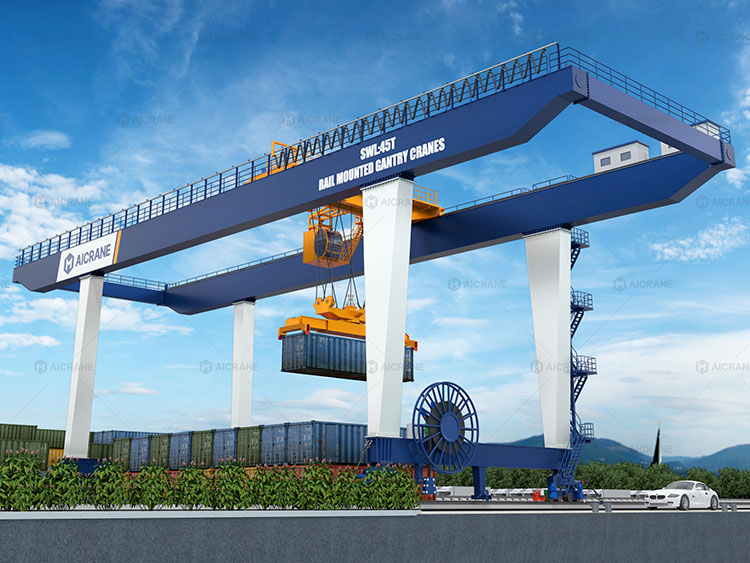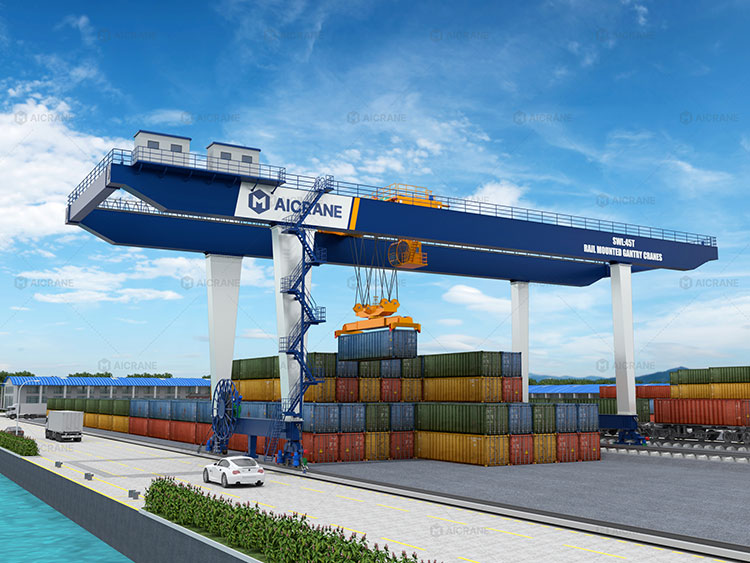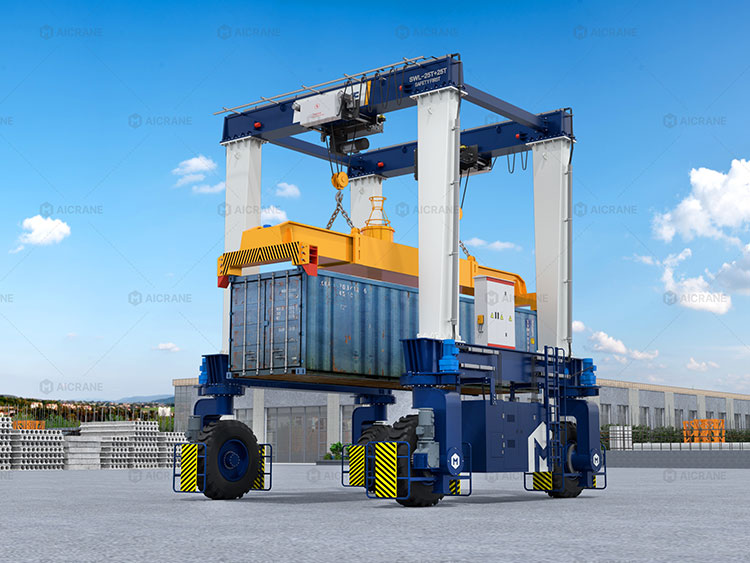Efficient container handling is vital to modern ports and container terminals. The heart of this efficiency lies in the cranes used for moving containers between ships, trucks, railcars, and storage yards. However, selecting the right type of container crane is not just about capacity or speed—it is also about how well the crane matches the layout and operational flow of the container yard. This article explores how to select the appropriate crane type based on container yard layout, highlighting the critical considerations and trade-offs involved.

Understanding Container Yard Layouts
Container yards vary widely depending on the size of the port, volume of traffic, mode of transport integration, and land availability. Generally, container yards are classified into several layout types:
-
Linear Layout
-
Containers are stacked in rows perpendicular to the quay.
-
Ideal for large-scale operations with ship-to-yard and yard-to-truck/rail operations occurring in parallel.
-
Requires cranes that can cover a wide area and have access to multiple rows efficiently.
-
-
Block Layout
-
Containers are stored in rectangular blocks, with roadways between the blocks for trucks or AGVs.
-
Common in high-density terminals with automated or semi-automated equipment.
-
Best suited for stacking cranes like RMGs or automated stacking cranes.
-
-
Pier-Back Layout
-
A simplified arrangement typically used in smaller terminals.
-
The yard is located directly behind the berth, and operations are mostly manual or semi-manual.
-
Rubber tyred gantry cranes or reach stackers are often preferred.
-
-
Satellite Layout
-
Storage blocks are located away from the main quay and accessed via internal transportation systems.
-
Requires effective intermodal systems and mobile equipment for container transfers.
-
Understanding the yard layout is the first step in determining which type of container crane is appropriate. Let’s now examine the container crane types and where they best fit in.
Types of Container Cranes
1. Rail Mounted Gantry Crane (RMG)
RMG cranes are widely used in block-type container yards. These rail mounted cranes run on rails and are known for their precision, high stacking capabilities, and automation potential.

Best Suited For:
-
Block layouts with high container stacking requirements.
-
Automated container terminals.
Advantages:
-
High stability and load capacity.
-
Accurate container positioning.
-
Lower operational costs in automated setups.
Disadvantages:
-
Limited mobility due to fixed rail paths.
-
Higher initial installation costs.
Ideal Yard Match:
Terminals with organized stacking areas and fixed traffic patterns—especially when automation is a priority.
2. Rubber Tyred Gantry Crane (RTG)
RTG cranes are mobile gantry cranes mounted on rubber tires. These rubber tired gantry cranes can move between container blocks and are widely used in medium to large ports.

Best Suited For:
-
Yards with flexible layouts.
-
Operations that require mobility between multiple container blocks.
Advantages:
-
High mobility and flexibility.
-
Lower infrastructure requirements compared to RMGs.
-
Adaptable to changing container layouts.
Disadvantages:
-
Higher fuel or electric consumption (depending on drive type).
-
Slightly less precise than RMGs.
Ideal Yard Match:
Container yards with a pier-back or linear layout where flexibility and reconfiguration of stacking areas are essential.
3. Straddle Carrier
Straddle carriers are wheeled vehicles that can lift and carry containers over short distances. They are often used in smaller yards or where high-speed operations are required.
Best Suited For:
-
Smaller or medium-sized yards.
-
Mixed traffic environments.
Advantages:
-
Self-sufficient (can load/unload containers independently).
-
High maneuverability in tight spaces.
Disadvantages:
-
Limited stacking height (usually up to 3 containers).
-
Higher maintenance needs for multiple units.
Ideal Yard Match:
Compact container yards with direct transfer from quay to truck or rail, often seen in European inland depots.
4. Reach Stacker
Reach stackers are similar to forklifts but designed to handle shipping containers. They are especially useful in small terminals or yards with limited investment capacity.
Best Suited For:
-
Small ports or satellite yards.
-
Low to medium volume terminals.
Advantages:
-
Highly flexible and mobile.
-
Low capital investment.
Disadvantages:
-
Limited stacking height and reach.
-
Less efficient for large-scale operations.
Ideal Yard Match:
Simple pier-back layouts or remote yards handling limited container volumes.
Key Factors to Consider When Matching Cranes to Yard Layouts
1. Stacking Density and Height
-
RMGs excel in high stacking applications due to their rigid rail structure.
-
RTGs offer moderate stacking and are suitable for most common layouts.
-
Straddle carriers and reach stackers are limited in stacking height.
2. Operational Flexibility
-
If your yard requires frequent changes to container stack arrangement, gantry mobile cranes like RTGs or reach stackers are more appropriate.
-
In structured layouts, RMGs and automated stacking cranes provide better efficiency.
3. Space Availability
-
Compact yards benefit from straddle carriers or reach stackers.
-
Large yards with ample space can accommodate rail systems for RMGs.
4. Budget Constraints
-
Reach stackers and straddle carriers have lower initial costs but may incur higher operating expenses over time.
-
RMGs and RTGs have higher upfront costs but can be more cost-effective in large, high-throughput terminals.
5. Automation and Technology Integration
-
Modern RMGs support full automation and integration with terminal operating systems (TOS).
-
RTGs are increasingly equipped with GPS and camera systems for semi-automation.
-
Straddle carriers and reach stackers may offer limited automation potential.
Conclusion: Aligning Crane Choice with Yard Strategy
Selecting the right container crane type isn’t just a technical decision—it’s a strategic one. The efficiency, cost, and scalability of a container yard operation depend heavily on how well the crane type integrates with the yard layout and handling processes.
For high-density, automated yards, RMGs are the go-to solution. For flexibility and moderate investment, RTGs strike a balance. Straddle carriers shine in tight spaces with fast turnover needs, while reach stackers suit small or developing yards where adaptability is essential.
In summary, always evaluate:
-
Your yard’s current layout and future growth potential.
-
The balance between capital investment and operational efficiency.
-
Your capacity and throughput targets.
-
Integration with surrounding transport infrastructure (truck, rail, ship).
By aligning crane type with yard design and operational goals, terminal operators can boost productivity, reduce bottlenecks, and remain competitive in an increasingly demanding logistics landscape.